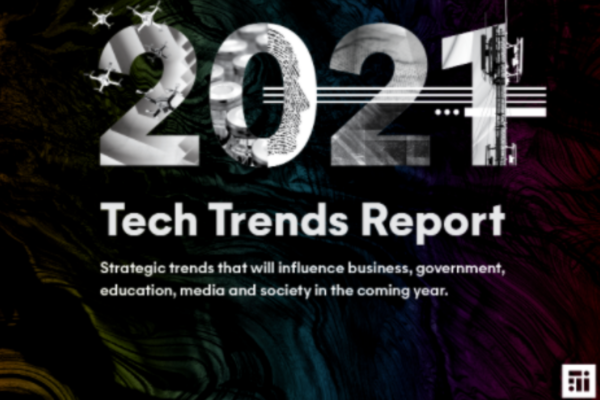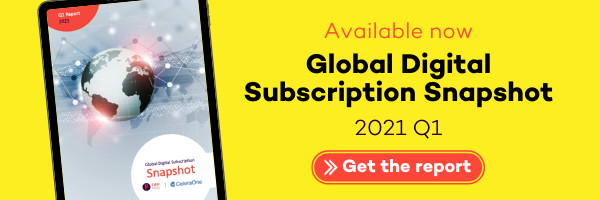Future Today Institute launches 14th annual Tech Trends Report
The Future Today Institute (FTI) has launched its 14th annual Tech Trends Report. Well, report singular is an understatement, because this year’s offering includes no less than twelve separate volumes, which between them analyse nearly 500 tech and science trends across multiple industry sectors! We’ve taken a preliminary look at the reports, and here summarise what some of the key findings could mean for the media industry, as well as the world at large.
“The 1920s began in chaos,” writes Future Today Institute Founder, CEO, and report Co-Author, Amy Webb, in her opening to this year’s Tech Trends Summary. (Always a reassuring start!) “Cataclysmic disruption resulting from the first world war and the Spanish flu shuttered businesses and provoked xenophobia. Technological marvels like the radio, refrigerator, vacuum cleaner, moving assembly line and electronic power transmission generated new growth, even as the wealth gap widened. The sheer scale of change, and the great uncertainty that came with it, produced two factions: those who wanted to reverse time and return the world to normal, and those who embraced the chaos.”

“It’s difficult not to see striking parallels to our modern world. A tumultuous US Election, extreme weather events and Covid-19 continue to test our resolve and our resilience. Exponential technologies – artificial intelligence, synthetic biology, exascale computing, autonomous robots, and off-planet missions to space – are challenging our assumptions about human potential. Under lockdown, we’ve learned how to work from our kitchen tables, lead from our spare rooms, and support each other from afar. But this disruption has only just begun.”
Across twelve reports, that disruption is looked at in detail, honing in on the following cluster trends:
- Artificial Intelligence (AI): enterprise, health, medicine & science, consumer, research, talent, creative, geopolitics, China.
- Scoring & Recognition: face, voice, gesture (and more) recognition, algorithmic scoring systems and surveillance.
- New Realities: Synthetic content and media, deepfakes, algorithmic content generation, streaming, AR/DR/VR/MR and journalism.
- Work, Culture, & Play: Tech trends related to the future of work, fashion, beauty, cognitive enhancers, vices, gaming, eSports, toys.
- Health & Medical: healthcare, medicine, Covid-19, smart fitness, smart glasses, watches + other wearables.
- Consumer Electronics: Tech trends covering the future of smart homes, rollable screens, consumer electronics and working from home.
- Government & Policy: geopolitics, geoeconomics, U.S. government (federal, state, local), policy and warfare.
- Privacy & Security: In-depth tech trends covering privacy and security. Plus a list of major breaches and a glossary for execs.
- Blockchain & Fintech: the future of blockchain, cryptocurrencies + fintech.
- 5G, Robots, Mobility: Strategic trends covering 5G, 6G, network infrastructure, robots, supply chain, logistics, drones + mobility.
- Energy, Climate, Space: energy, climate change and off-planet exploration. Plus deep-futures scenarios.
- Biotechnology & Agriculture: synthetic biology, CRISPR, mRNA, vaccines, brain-machine interfaces, agriculture and food.
Perhaps fittingly for an industry that seems to have been adapting to ‘the new normal’ for some decades now, the media sector is grouped in with the ‘New Realities’ section. Within that report, the Institute looks at everything from trust in journalism, to Diminished Reality – a form of augmented reality focused on suppressing existing elements of our physical environment.
Get stories like these directly in your inbox every week
Click here to subscribe to our (free) FIPP World Newsletter
We’ve picked out 5 key trends for the media industry here:
1. Trust in Media
It’s no secret that issues surrounding social media and fake news have not been good for the traditional consumer-journalist relationship in recent years. FTI predicts that ‘The spread of misinformation will continue until platforms and news organizations adopt norms and standards for accountability and trust.’
The report also looks at today’s media tech platforms within the context of the First Amendment, which prohibits any law limiting freedom with respect to religion, expression, peaceful assembly, or the right of citizens to petition the government. It’s what has made issues surrounding the censoring of hate speech on social media so tricky, and FTI also reminds us that while media tech platforms are global, ‘First Amendment legal protections are broad in scope but limited in geography: they only apply in the United States.’
2. Subscriptions Snapshot
An aptly worded sub-title for you there as we this week launch the latest FIPP/CeleraOne Digital Subscriptions report. FTI reminds us that this is becoming an increasingly crowded marketplace, because it’s no longer just media or even tech companies that are starting to wake up to the effectiveness of this monetisation model:
‘Whether it’s subscriptions, memberships, or donations, we’re living in the age of audience revenue. But the subscription economy is bigger than news paywalls, streaming video services, and direct-to-consumer offerings: Soon, more consumers will be asked to pay for virtual fashion, XR experiences, and gaming.’
3. Synthetic Media
FTI expects synthetic media to appear more frequently in 2021 and lists an abundance of companies such as Samsung Next, Loudly, and Endel that are already emerging players in this space. On the technology itself, they give the following definition:
‘Synthetic media is created using artificial intelligence. Algorithms use an initial set of data to learn – people, voices, photos, objects, motions, videos, text, and other types of media. The end result is realistic-looking and realistic-sounding artificial digital content. Voice clones, voice skins, unique gestures, photos, and interactive bots are all part of the ecosystem.’
All of which of course, comes with as many concerns as it does opportunities. Because just like the social media that grew up before it, synthetic media’s growth rate is outpacing the digital, physical, and policy infrastructure that surrounds it, not to mention simply the human eye’s inability to distinguish it from traditional content. If deepfakes were not necessarily considered a huge mainstream issue on the misinformation scale up until now – compared with say, Trump’s tweets – they soon might be.

Prominent attorney Robert Kardashian (left), who passed away in 2003, was re-created in holographic form (right) by production house Kaleida in 2020 as a birthday gift for his daughter Kim. Image: Getty Images/@kimkardashian, as featured in FTI 2021 Tech Trends
4. The End of Attention Metrics
Of course FIPP and likely most of the people reading this have looked extensively at the changes going on across the digital advertising landscape in recent weeks, most notably as relates Google. And notable also is that the Future Today Institute takes seriously issues surrounding fraudulent traffic, fake video views, and the likelihood that largescale digital advertising as we think of it today is almost certainly set to change dramatically:
‘As mainstream browsers increasingly block third-party tracking cookies by default, it will be harder to connect individuals to their actions across the web. Digital marketers and advertisers must find new ways to quantify the impact of their work – and to ensure that their partners trust their metrics.’
5. AR vs VR, MR vs XR, and DR is AR
We’ve looked many times over the years at the development of AR (Augmented Reality) vs VR (Virtual Reality) and of course how the media is leading the charge in creating both augmented and completely immersive experiences. Now roll up DR (Diminished Reality), which according to FTI can be conceptualised in the following way:
‘Diminished reality (DR) is the field of AR that focuses on virtually masking, reducing, or suppressing features of one’s environment,’ says the report. ‘As smart glasses proliferate and AR becomes commonplace over the next decade, DR presents an opportunity to virtually shape our reality rather than simply build on top of it.’

Diminished reality has the power to remove objects from view, seamlessly filling in backgrounds to mask the objects’ absence. Image: FTI tech Trends Report
It’s a fascinating development in the AR story, because after all what is a glass of wine and a good book after a long day if not an opportunity to escape the full stresses and strains of the outside world? (Please drink responsibly). One example that is given by the institute as representing a very early incarnation of DR is noise cancelling headphones, and by the way just to clarify on the remaining two anacronyms here: MR = Mixed Reality, while XR refers to ‘Extended Reality’, a phrase which is becoming something of an umbrella term for all forms of digital extension (or diminishment).
Overall, the FTI’s 14th annual Tech Trends Report provides a fascinating insight into the current state of play within the media tech industry, and some of the trends that we can likely expect to see making their way into the mainstream next. But of course, media tech is not only impacted by emerging trends, it is itself one of the key driving forces behind them, so we thought it would be fun to leave you with five of the most startling (and at times arguably scary!) future trends from the rest of the reports:
- Covid-19 accelerated the use of AI in drug discovery last year. The first trial of an AI-discovered drug is underway in Japan.
- E-doping is already an issue in professional eSports leagues, where Adderall and Ritalin are banned substances and using a cheat-code can get you banned for life.
- Homes are becoming sentient: Automated systems sense and adjust temperature, sound, light, and other functions in real time to support families.
- The attack on the US Capitol led to an unprecedented amount of cybersleuthing—everyday people finding and posting the identities of insurgents online.
- Some governments will consider granting the legal status of ‘electronic persons’ to sophisticated robots.
And remember… Don’t have nightmares!










